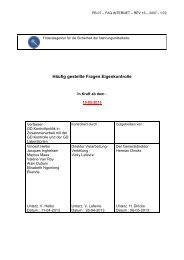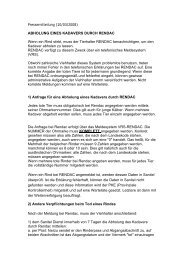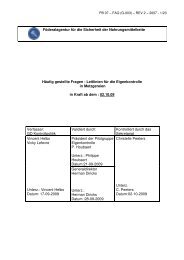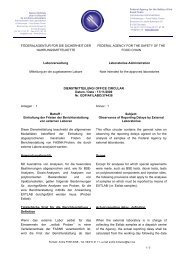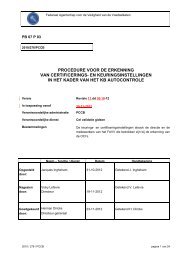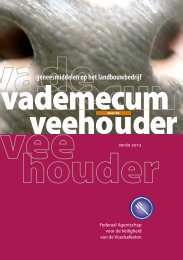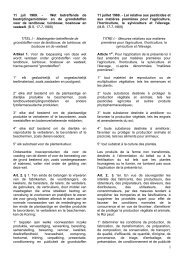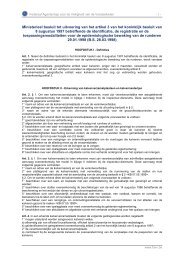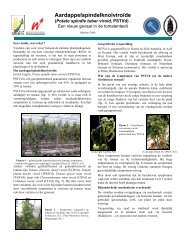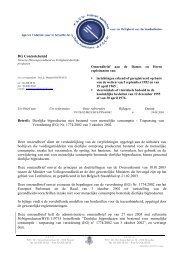AVIS 09-2010 Résumé Summary - Favv
AVIS 09-2010 Résumé Summary - Favv
AVIS 09-2010 Résumé Summary - Favv
Create successful ePaper yourself
Turn your PDF publications into a flip-book with our unique Google optimized e-Paper software.
EFSA (2008c) Polycyclic aromatic hydrocarbons in food. Scientific opinion of the Panel on<br />
Contaminants in the Food Chain. (Question No EFSA-Q-2007-136)<br />
http://www.efsa.europa.eu/EFSA/efsa_locale-1178620753812_1211902034842.htm<br />
EFSA (2007) Ethyl carbamate and hydrocyanic acid in food and beverages. Scientific opinion<br />
of the panel of contaminants. EFSA Question N°EFSA-Q-2006-076. The EFSA Journal<br />
551, 1-44. http://www.efsa.europa.eu/EFSA/efsa_locale-<br />
1178620753812_1178655060600.htm<br />
EFSA (2005a) Opinion of the Scientific Committee on a request from EFSA related to a<br />
harmonised approach for risk assessment of substances which are both genotoxic and<br />
carcinogenic (Request No EFSA-Q-2004-020). The EFSA Journal 280, 1-31.<br />
http://www.efsa.europa.eu/EFSA/efsa_locale-1178620753812_1178620763354.htm<br />
EFSA (2005b) Opinion of the Scientific Panel on Food Additives, Flavourings, Processing<br />
Aids and Materials in Contact with Food on a request from the Commission related to<br />
Semicarbazide in food. (Question number EFSA-2003-235) The EFSA Journal 219, 1-36.<br />
http://www.efsa.europa.eu/EFSA/Scientific_Opinion/afc_op_ej219_semicarbazide_en2.pdf<br />
EFSA (2004) Report of the Scientific Panel on Contaminants in the Food Chain on provisional<br />
findings on furan in food (Question N° EFSA-Q-2004-1<strong>09</strong>) The EFSA Journal 137, 1-20.<br />
http://www.efsa.europa.eu/EFSA/efsa_locale-1178620753812_1211902585476.htm<br />
European Commission Directorate-General Health and Consumer Protection (2004) Report of<br />
experts participating in Scientific Cooperation task 3.2.9 . “Collection and collation of data<br />
on levels of 3- monochloropropandiol (3-MCPD) and related substances in foodstuffs”,<br />
June 2004.<br />
http://ec.europa.eu/food/food/chemicalsafety/contaminants/mcpd_en.htm<br />
Esterbauer H. (1993) Cytotoxicity and genotocxicity of lipid-oxidation products. Am. J. Clin.<br />
Nutr. 57(suppl), 779S-786S.<br />
Fan X., Huang L., Sokorai K. (2008) Factors affecting thermally induced furan formation. J.<br />
Agric. Food Chem., 56 (20), 9490-9494.<br />
FDA (2007) DiNovi M. & Mihalov J. An updated exposure assessment for furan from the<br />
consumption of adult and baby foods. (Presentation, April 18, 2007)<br />
http://www.fda.gov/Food/FoodSafety/FoodContaminantsAdulteration/ChemicalContamina<br />
nts/Furan/ucm110770.htm<br />
Gangolli S., van den Brandt P., Feron V., Janzowsky C., Koeman J., Speijers G.,<br />
Spiegelhalder B., Walker R., Wishnok J. (1994) Nitrate, nitrite and N-nitroso compounds.<br />
Eur. J. Pharmacol. Environ. Toxicol. (Environ. Toxicol. Pharmacol.) 292, 1-38.<br />
Granvogl M., Koehler P., Latzer L. & Schieberle P. (2008) Development of a stable isotope<br />
dilution assay for the quantitation of glycidamide and its application to foods and model<br />
systems. Journal of Agricultural and Food Chemistry 56, 6087-6<strong>09</strong>2.<br />
Health Canada (2006) Health Risk assessment – Benzene in beverages. http://www.hcsc.gc.ca/fn-an/securit/chem-chim/food-aliment/benzene/benzene_hra-ers-eng.php<br />
Health Canada (2001) Canadian environmental protection act, 1999. Priority substances list<br />
assessment report. Formaldehyde. http://www.hc-sc.gc.ca/ewh-semt/alt_formats/hecssesc/pdf/pubs/contaminants/psl2-lsp2/formaldehyde/formaldehyde-eng.pdf<br />
Hwang M., Yoon E., Kim J., Jang D. & Yoo T. (20<strong>09</strong>) Toxicity value for 3-monochloropropane-<br />
1,2-diol using a benchmark dose methodology. Regulatory Toxicology and Pharmacology<br />
53, 102–106.<br />
IARC (2000) Glycidol. IARC Monographs, 77:469–486.<br />
http://monographs.iarc.fr/ENG/Monographs/vol77/mono77-19.pdf<br />
Jakszyn P., Bingham S., Pera G., Agudo A., Luben R., Welch A., Boeing H., del Giudice G.,<br />
Palli D., Saieva C., Krogh V., Sacerdote C., Tumino R., Panico S., Berglund G., Sima´n H.,<br />
Hallmans G., Sanchez J.M., Larrañaga N., Barricarte A., Chirlaque M.D., Quiro´s J., Key<br />
T., Allen N., Lund E., Carneiro F., Linseisen J., Nagel G., Overvad K., Tjonneland A.,<br />
Olsen A., Bueno-de-Mesquita H.B., Ocke´ M.O., Peeters P., Numans M., Clavel-Chapelon<br />
F., Trichopoulou A., Fenger C., Stenling R., Ferrari P., Jenab M., Norat T., Riboli E. &<br />
Gonzalez C. (2006) Endogenous versus exogenous exposure to N-nitroso compounds<br />
and gastric cancer risk in the European Prospective Investigation into Cancer and Nutrition<br />
(EPIC-EURGAST) study. Carcinogenesis 27(7), 1497–1501.<br />
JECFA (2006) <strong>Summary</strong> and conclusions of the sixty-fourth meeting of the joint FAO/WHO<br />
Expert Committee on Food Additives (7 July 2006). Rome, 20-29 June 2006.<br />
http://www.who.int/ipcs/food/jecfa/summaries/summary67.pdf<br />
29/32



